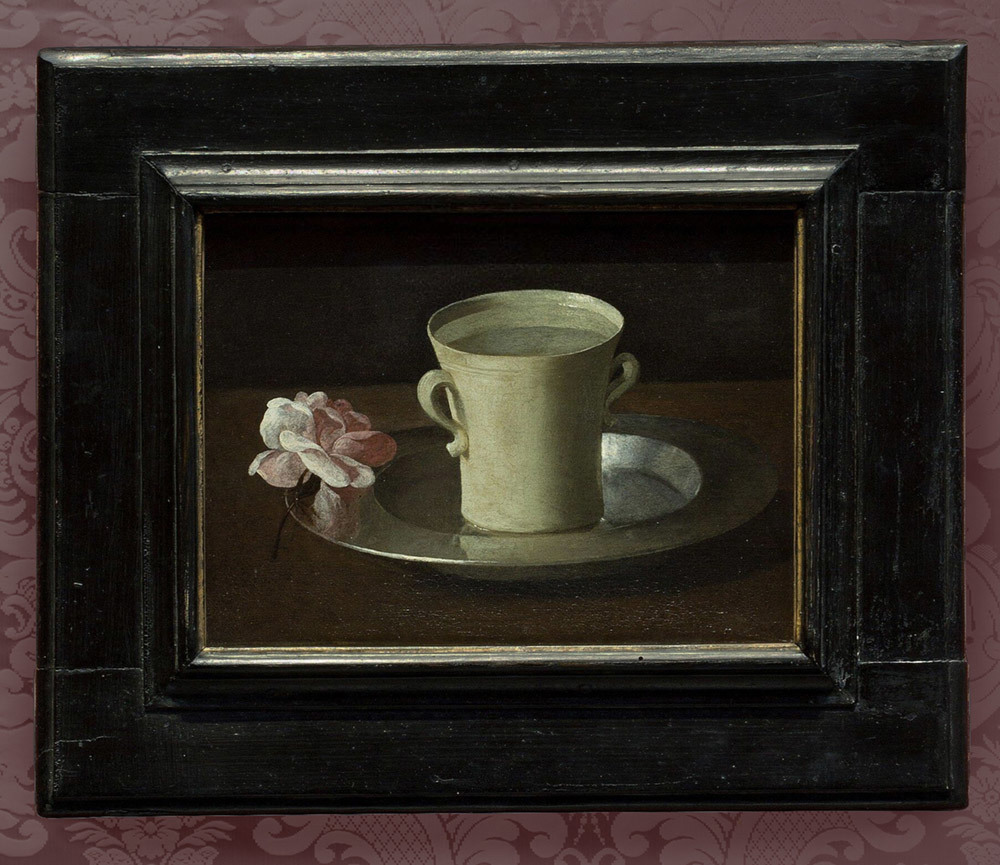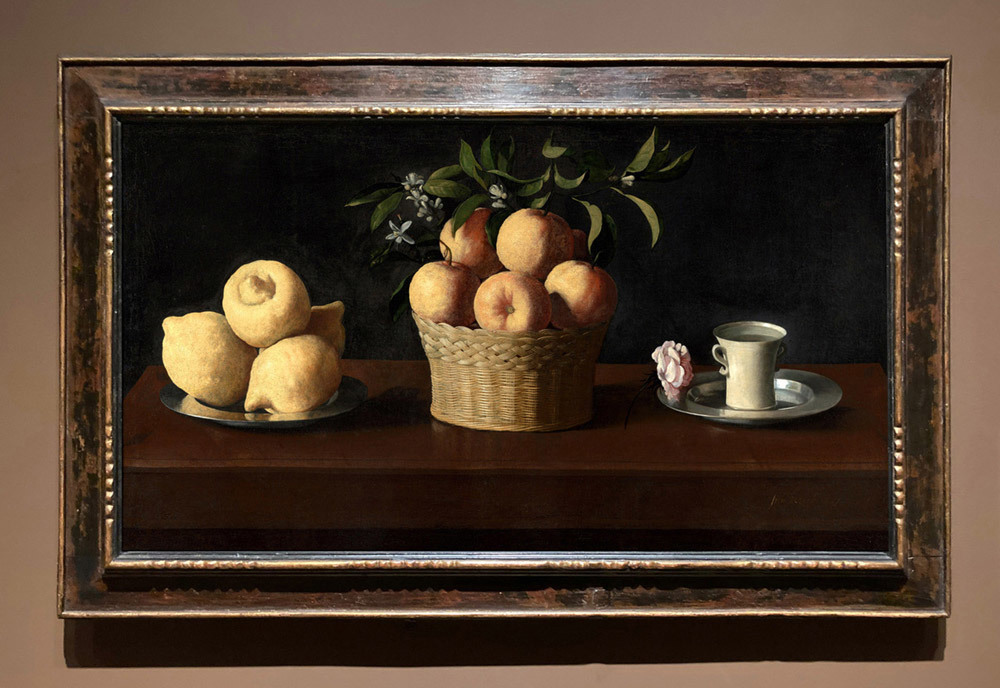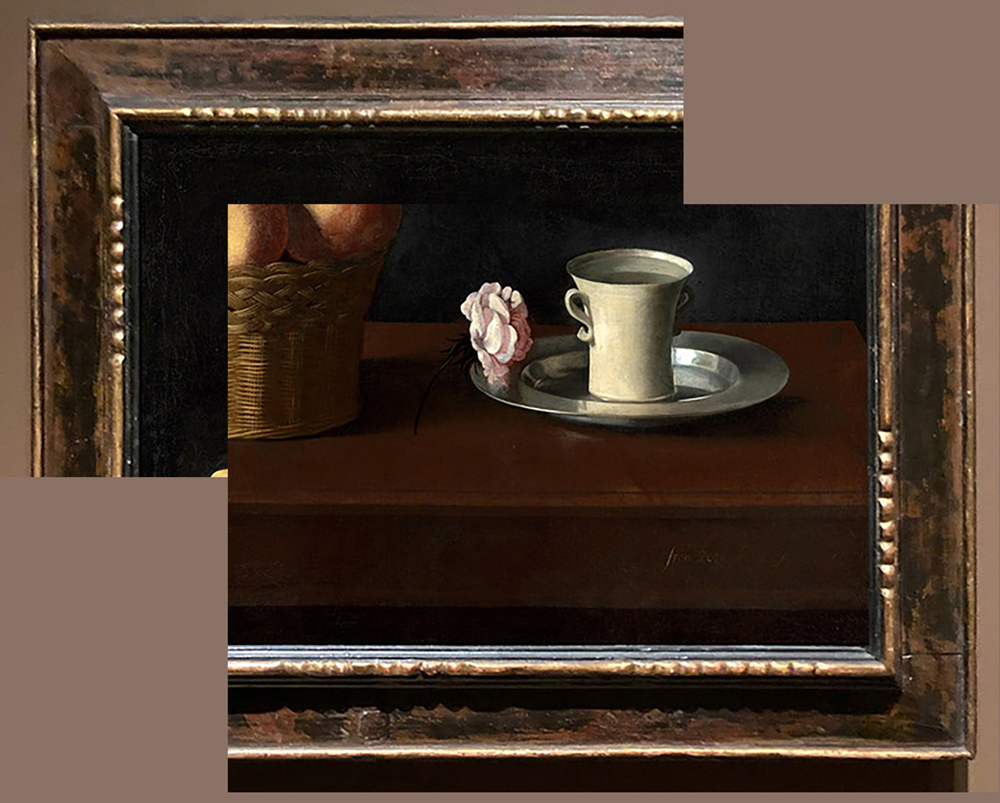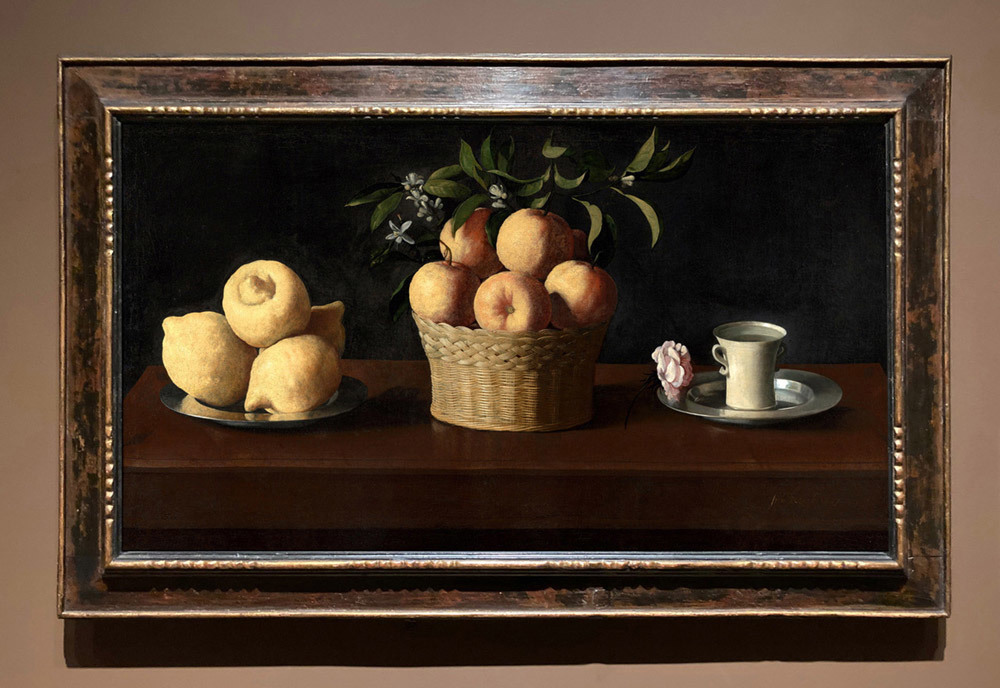Reframing Francisco de Zurbarán, Still life with lemons, oranges and a rose, 1633, Norton Simon Foundation
Posted: 01 Dec 2025 by PML

Francisco de Zurbarán (1598-1664), Still life with lemons, oranges and a rose, 1633, o/c, 62.2 x 109.5 cm, Norton Simon Foundation
Zurbarán's painting is at once a masterly depiction of mundane items - a cup of water, a flower, piles of citrus fruit, a slightly worn table - and a piercing, hallucinatory vision of objects which have somehow become laden with a significance beyond the everyday. Unlike many other 17th century painters of still life arrangements containing flowers, fruit and other foods, he has avoided any sense that these are ephemeral: that they were alive and growing but have been gathered and brought indoors, where they will quickly age and rot - a vivid lesson on the transience of human life. Instead, Zurbarán's oranges and lemons have been translated, in a quite inexplicable way, into immortal fruit from the table of the gods, and his orange blossoms and rose are unwitherable flowers which might have crowned Aphrodite.
He was also a deeply Catholic painter, however, specializing in religious scenes and single figures of saints (often set in the same shallow space as the still life above, lacking recession and merging into a night-black ground, invested with a similar hyper-reality). Thus when he paints fruit, it is never actually pagan fruit from a mythological picnic of the gods, but a way of presenting the lives of Christ and the Virgin in a profound meditation on their meaning, and as a door opening to prayer. The lemons are an attribute of the Virgin, with their bitterness alluding to her grief at the death of her Son; the oranges are a variant on the apple, the fruit of the Tree of the Knowledge of Good and Evil, and so represent the Fall of Man which Christ came to repair.

Zurbarán, A cup of water and a rose, c.1630, National Gallery, London, NG 6566
The rose and orange blossom are other attributes of Mary - the first symbolizing her sweetness and lack of 'thorns' (or sin), and the second her purity. Clear water in a white cup also represents her purity. The three groups of fruit and flowers are a reminder of the heavenly Trinity, but, because of their individual symbolic significance, they stand for another trinity as well - Adam, who caused the Fall and brought sin into the world, the Virgin who bore Christ to redeem it, and Christ Himself. The small painting of the cup of the water and the rose in the National Gallery seems to have been painted first, and may be a version of the intimate domestic altarpiece, meant for personal contemplation of the life of the Virgin Mary; whilst the larger work in the Norton Simon Museum was perhaps intended for a slightly larger setting, in a monastery or convent - possibly even commissioned for a refectory, where the fruit was both appropriate and a pointer towards further meditation and prayer.

Francisco de Zurbarán (1598-1664), Still life with lemons, oranges and a rose, 1633, o/c, 62.2 x 109.5 cm, in previous frame, Norton Simon Foundation
Unfortunately all this profundity, delicacy and symbolism had been smothered by the carved giltwood frame given to the painting by a previous owner in Florence. This kind of sculptural garland - also incorporating symbolic fruit (pomegranates for resurrection, roses for the Virgin, poppy heads for earthly transience, peaches for truth, peapods for the Virgin's fertility, pears for Christ) - was adopted in the Renaissance from Roman sarcophagi, where fruit in general referred to the harvest goddess Ceres or Demeter, and hence to rebirth and life beyond death.

Luca Signorelli (c.1450-d.1523), Holy Family & saint, 1490-92, o/panel, 99 cm, Galleria Palatina, Palazzo Pitti, Florence
It was used by the Della Robbia family for their blue and white ceramic tondi and altarpieces, for which the colourful wreaths of leaves and fruit formed the perfect eye-catching border. When translated into carved and gilded tondo frames for paintings of the Madonna and Child or the Holy Family, it was equally effective - not conflicting with the compositions, but presenting them as precious jewels in a goldsmith's setting, which was both decorative and also provided a sort of pictogram commentary on the religious scene, for worshippers who could not read.
However, Zurbarán's highly symbolic, superlatively still, still life, freighted with presence and meaning, surrounded by the busy, slightly clunky 19th century copy of a garland frame, its fat torus far too near the paper-sharp orange leaves and fragile blossoms, was an unhappy mismatch. The painting was rescued by the curatorial will to present the painting properly to the world (the only work actually signed and dated by the artist), and by the solution found by Paul Mitchell Ltd.

Francisco de Zurbarán (1598-1664), Still life with lemons, oranges and a rose, 1633, o/c, 62.2 x 109.5 cm, in current PML frame, Norton Simon Foundation
This, like the frame of the National Gallery Cup of water and a rose, is a 17th century Spanish reverse profile frame (in other words, the highest part is nearest the sight edge, pushing the painting out towards the viewer in a typically Baroque gesture). It is similarly sparsely decorated, in keeping with Zurbarán's severely pared-down style, having only the gilt astragal with groups of beading at the sight edge, the gilt back edge, and the muted, painted frieze. Otherwise this whole frame is an exercise in subdued geometrical forms - long, straight mouldings which echo the lines of the painted table; flat planes, which mirror the shallow space; small architectural ornaments which harmonize with the minutely observed details of basket, rind and flower.

The warm browns and blacks in which the frieze is painted harmonize similarly with the tones of the painting; they have been described at faux-marbre, painted stone, but they may actually be intended to represent tortoiseshell. This precious and versatile material had been used in Spain since the 15th century[1], when Columbus annexed the island of Hispaniola for the crown of Castile and the natural riches of the Caribbean began to flow to Europe. It had previously been known in Italy by the Romans, who obtained it from Egypt. Tortoise- (really turtle-) shell was malleable when heated, and could be used for inlays on fashionable cabinets and caskets; in the Low Countries it was shaped to cover the mouldings of Baroque looking-glass frames, so it was a short jump to produce a similar effect with paint on the frieze of an otherwise austere black frame. This decoration is still muted, still minimalist, still an economical finish which would have suited the requirements of - say - a monastery; yet at the same time it reproduces one of the most fashionable and exotic materials of the 17th century: something which would have been thought as appropriate as gold leaf in that hypothetical monastery in which to present a sacred or symbolic painting.

References
1'Natural plastics', 2005; quoted by Thomas Hainschwang and Laurence Leggio, 'The characterization of tortoiseshell and its imitations', Gems & gemology, vol. 42, no 1, p. 36
Categories
- Articles on multiple aspects of European frames
- Recent framing projects undertaken by Paul Mitchell Ltd
